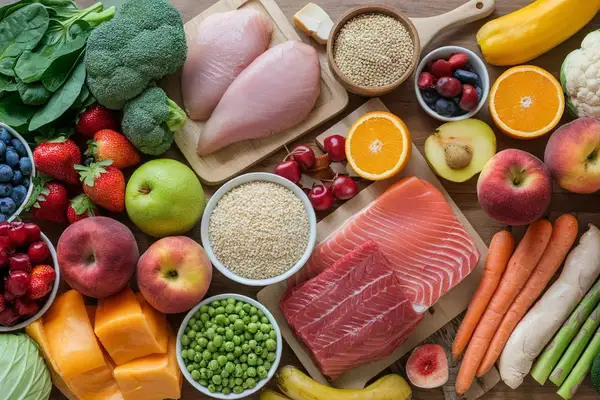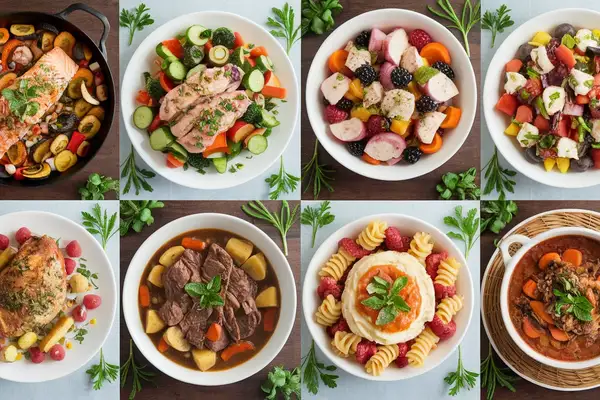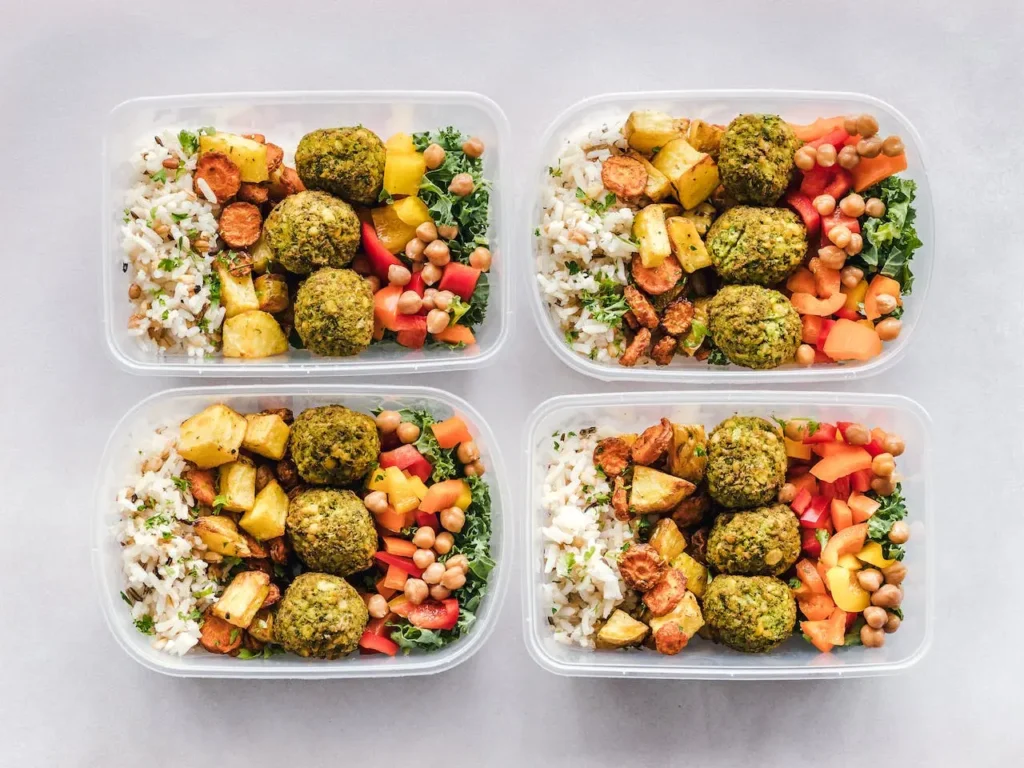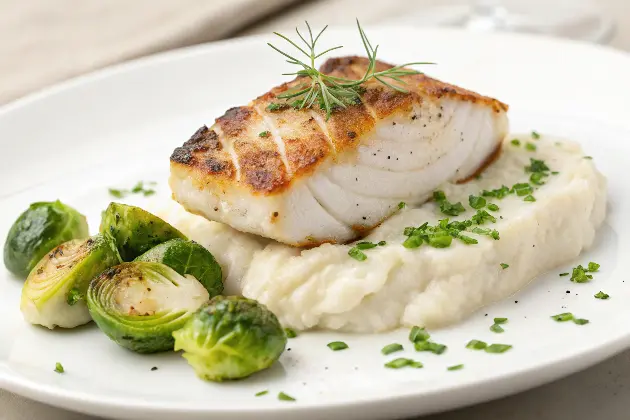7-Day Low Glycemic Diet Plan for Managing Blood Sugar
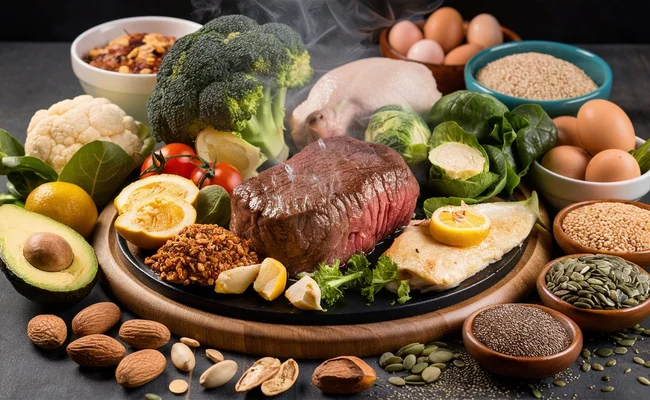
This post may contain affiliate links, meaning I may earn a commission if you make a purchase, at no extra cost to you. I only recommend products I trust. Thank you for your support.
The low glycemic diet has gained popularity in recent years due to its potential health benefits and effectiveness in managing blood sugar levels.
This comprehensive guide will provide you with a detailed 7-day low glycemic diet plan, along with essential information about low glycemic foods, their benefits, and tips for successful implementation.
What is a Low Glycemic Diet?
A low glycemic diet is an eating plan that focuses on consuming foods with a low glycemic index (GI). The glycemic index is a measure of how quickly a food can raise blood sugar levels.
By choosing foods with a low GI, you can help stabilize blood sugar levels, which may lead to various health benefits.
Foods are ranked on a scale from 0 to 100, with lower numbers indicating a slower impact on blood sugar:
- Low GI: 1 to 55
- Medium GI: 56 to 69
- High GI: 70 and higher
Low Glycemic Index Foods List
Here’s a comprehensive list of low glycemic foods to incorporate into your low glycemic diet:
1. Fish and Seafood (GI: 0)
- Salmon
- Trout
- Tuna
- Sardines
- Prawns
- Cod
- Halibut
- Mackerel
2. Lean Meats (GI: 0)
- Beef (lean cuts)
- Pork (lean cuts)
- Lamb (lean cuts)
3. Eggs (GI: 0)
- Whole eggs, egg whites, or egg substitutes
4. Poultry (GI: 0)
- Chicken
- Turkey
- Duck
5. Tofu and Soy Products (GI: 15-20)
- Tofu (GI: 15)
- Tempeh (GI: 15)
- Edamame (GI: 20)
6. Low Glycemic Fruits (GI < 55)
- Apples (GI: 36)
- Pears (GI: 38)
- Oranges (GI: 43)
- Strawberries (GI: 41)
- Peaches (GI: 42)
- Plums (GI: 39)
- Grapefruit (GI: 25)
- Cherries (GI: 22)
- Avocado (GI: 40)
7. Low Glycemic Vegetables (GI < 55)
- Broccoli (GI: 10)
- Cauliflower (GI: 10)
- Spinach (GI: 15)
- Lettuce (GI: 15)
- Tomatoes (GI: 30)
- Bell peppers (GI: 15)
- Carrots (GI: 35)
- Green beans (GI: 15)
8. Low Glycemic Carbs (GI < 55)
- Quinoa (GI: 53)
- Barley (GI: 28)
- Lentils (GI: 32)
- Chickpeas (GI: 28)
- Boiled sweet potatoes (GI: 44)
- Whole grain pasta (GI: 42)
- Steel-cut oats (GI: 52)
9. Low Glycemic Cereals (GI < 55)
- All-Bran (GI: 30)
- Steel-Cut Oats (GI: 42)
- Muesli (GI: 40-50)
10. Low Glycemic Snacks (GI < 55)
- Nuts (almonds, walnuts, pistachios)
- Seeds (pumpkin, sunflower, chia)
- Hummus with vegetable sticks
- Greek yogurt with berries
- Hard-boiled eggs
11. Low Glycemic Desserts
- Fresh fruit salad with a dollop of Greek yogurt
- Dark chocolate (70% cocoa or higher) in moderation
- Chia seed pudding with almond milk and berries
- Baked apples with cinnamon and a sprinkle of nuts
- Homemade frozen yogurt popsicles with low-GI fruits
7-Day Low Glycemic Diet Plan (Low Glycemic Diet Menu)
This 7-day low glycemic diet Plan includes a variety of delicious and nutritious meals designed to help stabilize blood sugar levels, boost energy, and support overall health.
Each day features a mix of low glycemic index foods such as whole grains, lean proteins, fresh fruits, and vegetables, ensuring balanced nutrition while promoting gradual, sustained glucose release.
This low GI diet plan emphasizes whole, minimally processed foods to provide essential nutrients and maintain a healthy metabolic rate.
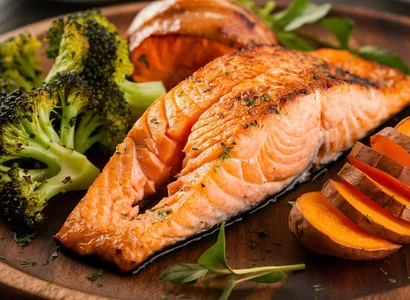
Day 1
Breakfast:
- Steel-cut oats with sliced almonds and berries: Cook steel-cut oats (½ cup dry), and top with sliced almonds (2 tbsp) and fresh berries (½ cup).
Lunch:
- Quinoa salad with grilled chicken, mixed vegetables, and olive oil dressing: Toss cooked quinoa (¾ cup) with grilled chicken (4 oz), mixed vegetables (1 cup), and drizzle with olive oil dressing (1 tbsp).
Dinner:
- Baked salmon with roasted broccoli and sweet potato: Bake salmon fillets (6 oz) and serve with roasted broccoli (1 cup) and boiled sweet potato (1 medium).
Snacks:
- Apple slices with almond butter: Serve 1 medium apple sliced with almond butter (2 tbsp).
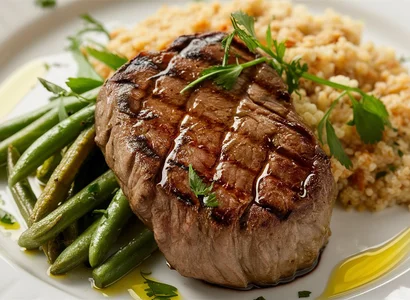
Day 2
Breakfast:
- Greek yogurt parfait with low-GI fruits and a sprinkle of chia seeds: Layer Greek yogurt (1 cup) with low glycemic index fruits (½ cup) and top with chia seeds (1 tbsp).
Lunch:
- Lentil soup with a side salad and whole grain bread: Enjoy lentil soup (1 cup) paired with a side salad (2 cups mixed greens) and whole grain bread (1 slice).
Dinner:
- Grilled lean beef with sautéed green beans and quinoa: Grill lean beef (5 oz) and serve with sautéed green beans (1 cup) and quinoa (¾ cup).
Snacks:
- Carrot sticks with hummus: Dip carrot sticks (1 cup) in hummus (2 tbsp).
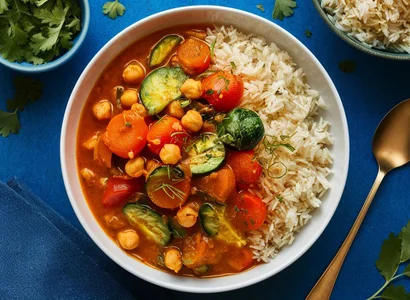
Day 3
Breakfast:
- Vegetable omelet with whole grain toast: Make an omelet with mixed vegetables (1 cup) and serve with whole grain toast (1 slice).
Lunch:
- Chickpea and vegetable curry with brown rice: Cook chickpeas (1 cup) and vegetables (1 cup) in curry sauce, and serve over brown rice (¾ cup).
Dinner:
- Baked chicken breast with roasted Brussels sprouts and barley: Bake chicken breast (6 oz) and serve with roasted Brussels sprouts (1 cup) and barley (¾ cup).
Snacks:
- Mixed nuts and seeds: Enjoy a mix of nuts and seeds (¼ cup).
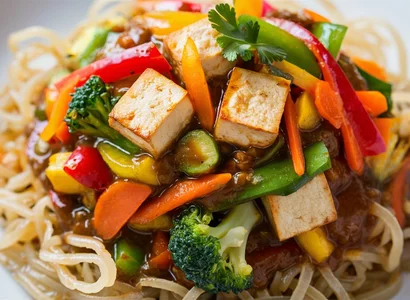
Day 4
Breakfast:
- Smoothie made with berries, spinach, Greek yogurt, and almond milk: Blend together berries (½ cup), spinach (1 cup), Greek yogurt (½ cup), and almond milk (1 cup).
Lunch:
- Tuna salad with mixed greens and cherry tomatoes: Mix tuna (4 oz) with greens (2 cups) and cherry tomatoes (½ cup).
Dinner:
- Stir-fried tofu with mixed vegetables and Shirataki noodles: Stir-fry tofu (4 oz) with mixed vegetables (1 cup) and serve over brown rice noodles (1 cup).
Snacks:
- Celery sticks with peanut butter: Spread peanut butter (2 tbsp) on celery sticks (1 cup).
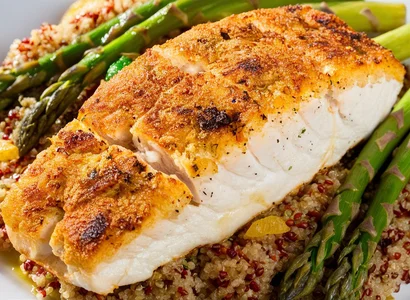
Day 5
Breakfast:
- Whole grain toast with avocado and poached eggs: Top whole grain toast (1 slice) with mashed avocado (½ medium) and poached eggs (2 eggs).
Lunch:
- Grilled vegetable and mozzarella sandwich on whole grain bread: Grill vegetables (1 cup) and mozzarella (2 oz) and serve on whole grain bread (2 slices).
Dinner:
- Baked cod with roasted asparagus and quinoa: Bake cod fillets (6 oz) and serve with roasted asparagus (1 cup) and quinoa (¾ cup).
Snacks:
- Low-fat cheese with grape tomatoes: Pair low-fat cheese (1 oz) with fresh grape tomatoes (½ cup).

Day 6
Breakfast:
- All-Bran cereal with milk and sliced peaches: Serve All-Bran cereal (1 cup) with milk (1 cup) and top with sliced peaches (½ cup).
Lunch:
- Turkey and vegetable wrap with whole grain tortilla: Wrap turkey (4 oz) and vegetables (1 cup) in a whole grain tortilla.
Dinner:
- Lentil and vegetable soup with a side salad: Enjoy a warm lentil and vegetable soup (1 cup) with a fresh side salad (2 cups mixed greens).
Snacks:
- Homemade trail mix with nuts, seeds, and dried berries: Mix nuts, seeds, and dried berries (¼ cup total) for a homemade trail mix.

Day 7
Breakfast:
- Buckwheat pancakes with fresh berries and a dollop of Greek yogurt: Make buckwheat pancakes (3 small) and top with fresh berries (½ cup) and Greek yogurt (2 tbsp).
Lunch:
- Grilled chicken Caesar salad with homemade dressing: Grill chicken (4 oz) and toss with Caesar salad (2 cups) and homemade dressing (1 tbsp).
Dinner:
- Baked pork tenderloin with roasted vegetables and barley: Bake pork tenderloin (6 oz) and serve with roasted vegetables (1 cup) and barley (¾ cup).
Snacks:
- Sliced pear with a small handful of walnuts: Serve sliced pear (1 medium) with a handful of walnuts (¼ cup).
Benefits of a Low Glycemic Diet
Following a low glycemic diet can offer several potential health benefits:
- Improved blood sugar control: Low glycemic foods are digested and absorbed more slowly, preventing rapid spikes in blood sugar levels and reducing the risk of hyperglycemia (high blood sugar).
- Weight management: Low glycemic diets may help with weight loss and maintenance by promoting feelings of fullness and reducing hunger.
- Reduced risk of heart disease: Some studies suggest that low GI diets may help lower total and LDL (bad) cholesterol levels.
- Improved energy levels: By avoiding rapid spikes and crashes in blood sugar, a low glycemic diet can help maintain steady energy throughout the day.
- Potential cancer risk reduction: Some research indicates that low GI diets may be associated with a reduced risk of certain types of cancer.
High Glycemic Foods to Avoid
While following a low glycemic diet, it’s important to limit or avoid high glycemic foods, such as:
- White bread and bagels
- White rice
- Instant oatmeal
- Most breakfast cereals
- Potatoes (especially mashed or instant)
- Sugary snacks and candies
- Soft drinks and sweetened beverages
- Watermelon (although it has a low glycemic load due to its high water content)
- Dried fruits like dates and raisins
Low Glycemic Diet Tips
- Combine foods wisely: Pairing low GI carbs with protein and healthy fats can help slow digestion and further stabilize blood sugar levels.
- Practice portion control: Even low glycemic foods can impact blood sugar if consumed in large quantities. Be mindful of portion sizes to manage overall carbohydrate intake.
- Stay hydrated: Drink plenty of water throughout the day. Staying hydrated supports overall metabolic health and helps regulate blood sugar levels.
- Use low glycemic sweeteners: Replace high glycemic sweeteners like table sugar and corn syrup with lower glycemic options such as stevia, monk fruit, or coconut sugar.
- Incorporate high fiber foods: Foods high in fiber generally have a lower glycemic index. Fiber slows the digestion and absorption of carbohydrates, leading to a more gradual increase in blood glucose.
- Plan balanced meals: Ensure each meal includes a balance of low glycemic carbohydrates, proteins, and healthy fats. This helps maintain stable blood sugar levels and provides sustained energy.
Conclusion
This 7-day low glycemic diet plan offers a practical and sustainable approach to managing blood sugar levels and improving overall health.
By focusing on foods with a low glycemic index, you can potentially experience a range of benefits, from better weight management to reduced risk of chronic diseases.
The low glycemic diet is not about eliminating carbohydrates but rather choosing the right types of carbs that have a minimal impact on blood sugar levels.
The low glycemic approach can be adapted to various dietary preferences, including vegetarian and vegan diets, making it a flexible option for many individuals.
Everyone’s body responds differently to foods. It’s essential to monitor your own responses and adjust the diet accordingly.
By stabilizing blood sugar levels, a low glycemic diet may contribute to improved energy levels, better appetite control, and potentially reduced risk of type 2 diabetes and heart disease.
- 7-day Aldi meal plan
- High alkaline diet plan
- 7-day candida diet meal plan
- 14-day real food diet plan
- 7-day meal plan for high blood pressure
- 7-day meal plan for cancer patients
- Mounjaro diet plan
- Dukan diet food list
- Lion diet foods to eat and avoid
- Carnivore diet plan
- Weekly weight loss recipes
- What is Mounjaro?
- Ozempic diet recipes
- Easy animal-based diet recipes
- Zero carb foods
- BRAT diet recipes
FAQs
What is low glycemic index?
The glycemic index (GI) is a measure of how quickly a food can raise blood sugar levels. A low glycemic index typically refers to foods with a GI value of 55 or less.
These foods are digested and absorbed more slowly, leading to a gradual rise in blood sugar levels.
Is coconut sugar low glycemic?
Coconut sugar has a slightly lower glycemic index (GI: 54) compared to regular table sugar (GI: 65). However, it’s still considered a form of added sugar and should be consumed in moderation.
What foods have a 0 glycemic index?
While no food has a glycemic index of exactly zero, foods that contain no carbohydrates, such as meats, fish, eggs, cheese, and oils, are considered to have a glycemic index of 0 because they don’t affect blood sugar levels.
Are eggs low in glycemic?
Yes, eggs are considered to have a glycemic index of 0 because they contain no carbohydrates. They can be an excellent addition to a low glycemic diet.
Is rice low glycemic?
The glycemic index of rice varies depending on the type. White rice typically has a high GI (64-89), while steamed brown rice has a low GI (50-55). Some varieties like whole grain basmati rice have a lower GI (50-52), making them a better choice for a low glycemic diet.
Are bananas low in glycemic?
No, ripe bananas have a medium glycemic index of about 60. However, less ripe bananas have a lower GI.
Is chicken low glycemic?
Yes, chicken is considered to have a glycemic index of 0 because it contains no carbohydrates. It’s an excellent protein source for a low glycemic diet.
Disclaimer: The information provided in this article about the low glycemic diet is for general informational purposes only and is not intended to be a substitute for professional medical advice, diagnosis, or treatment.
